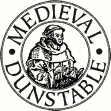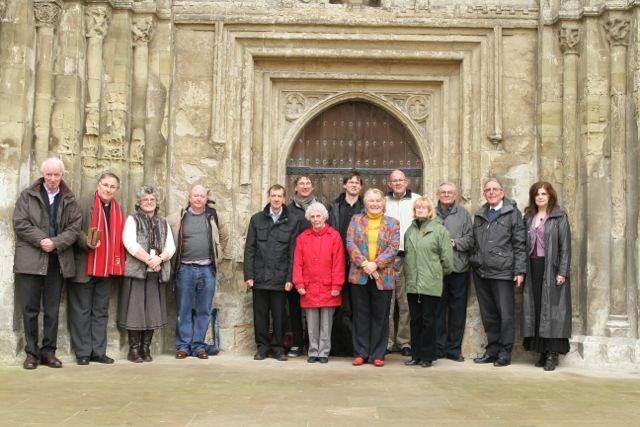
Medieval Dunstable© Webmaster Helen Mortimer Privacy Policy | Terms of Use



The Project the beginning and the end
In the summer of 2010 I had an idea that perhaps we could mark the foundations of the Augustinian Priory, and introduce a new Medieval Walk to the Heritage walks offered by the town guides. Those of us interested in the history of the town believed that in medieval times, Dunstable was an important centre of trade sitting astride one of the busiest crossroads of England. Henry I built a palace in Dunstable and a number of monarchs spent time here. We knew there were jousts, we had a copy of some early byelaws and charters, tantalising evidence that there was a big story just waiting to be uncovered.
Having spoken to a number of our historians, and taken the idea to the Promoting Dunstable' group, the project started to grow. The town has many surviving records including the Priory Annals, diaries that were kept by the Priory in the 1200’s. Written in Medieval Latin, these annals have never before been fully translated. I was told that these annals were internationally important and must be published. Here was another story waiting to be told.
In May 1533, just a few years before Henry VIII closed our Priory, he sent Cranmer and the bishops to Dunstable to grant him an annulment from Catherine of Aragon. The ending of this marriage resulted in the break from Rome and the beginning of the Reformation. This event in British history surely deserves to be recorded with a plaque on the very spot where it happened.
October 2013 is the 800th anniversary of the dedication of the Augustinian Priory and so it is a great time to celebrate this event by delving into the early history of the Priory and of the town where it had so much influence.
Our aim is for Dunstable to be recognised as the important site that it was during the Medieval period. We hope that what we find and record will attract more visitors and tourists, bringing footfall and money to the retailers, the evening economy, Priory House Heritage Centre and Priory Church.
And so our Medieval Dunstable project began to take shape. Over 30 different local organisations offered support, including 12 schools, the scouts, the town churches, the district and town councils in addition to the historians and archaeologists. Our wish list of projects came to £63,000, far more than the £50,000 Heritage Lottery Fund. The group were contributing time, budgets and expertise worth £92,000.
Throughout the winter of 2011 we decided the priorities, and in April, I posted our bid for £49,900 to carry out a Medieval Dunstable Project. We were notified in July that Promoting Dunstable' had been granted the full amount.
The story begins here with the different parts of the project, and will end with the publication of the team's medieval research. This will be the first time this material has ever been collected and made available to everyone all in one place. This information will be available as a book, on this website, and on a DVD. In addition, the fully translated Dunstable Annals will be published as a separate book by David Preest. All of these items will be on sale at Priory House by the autumn of 2013, and through their website.
There will also be a portable medieval exhibition demonstrating everyday life, for use in the heritage centre, schools and talks.
We will advertise the project and carry out talks to schools, churches and town groups of all ages as the research progresses – there will be free packs for schools/media and a leaflet to target coach companies and groups to the town all available in 2013 from Dunstable Tourist Information Centre at Priory House.
The book launch will be in the summer of 2013 along with a number of events to celebrate the 800th anniversary of the dedication of the Priory.
The aim is to put Dunstable firmly on the Medieval Tourist map.
Contact
Jean Yates
Project Manager

Some of our project team
| Archaeology |
| Audio Guides |
| Education |
| Exhibitions |
| Events 2013 |
| Physic Garden |
| Priory History |
| Priory Churches / Lands |
| Town History |
| Virtual Tour |
| Website |
| Archaeology |
| Charters & Bylaws |
| Eleanor Cross |
| Famous People |
| The Fraternity |
| Friary |
| Guided Tours |
| History |
| Inns |
| Dunstable Treasures |
| Kingsbury |
| Middle Row |
| Royal Visits |
| Sheep & Wool Trade |
| The Town |
| Friary Archaeology |
| Bone Study |
| Friary |
| Annals Charters Valor Ecc |
| Archaeology |
| Churches and Lands |
| Guided Visits |
| Audio Guides |
| History |
| Monastic Life |
| Virtual Tour |
| The Augustinian Priory |
| The Canons Route |
| Bedfordshire |
| Buckingham |
| Derbyshire |
| Nothamptonshire |
| Hertfordshire |
| Leicestershire |
| Oxon |
| Priors |
| Annulment |
| History |
| Archives |
| Book Sales & Shop |
| Exhibitions |
| Guided Walks |
| Heritage Talks |
| Physic Gardens |
| Schools |
| Tourist Information Centre |
| Tea-room |
| Visits |
| Priory House Heritage Centre |
| Education |
| Knight |
| Search Results |